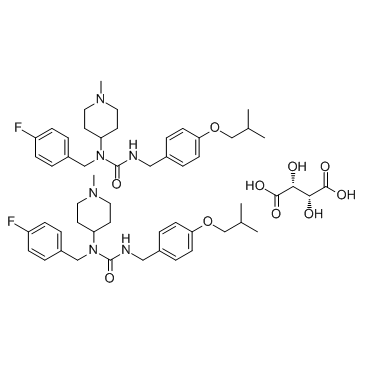706782-28-7
| Name | Pimavanserin Tartrate |
|---|---|
| Synonyms |
Nuplazid
N-[(4-Fluorophenyl)methyl]-N-(1-methyl-4-piperidinyl)-N’-[[4-(2-methylpropoxy)phenylurea (2R,3R)-2,3-Dihydroxybutanedioate N-[(4-Fluorophenyl)methyl]-N-(1-methyl-4-piperidinyl)-N’-[[4-(2-methylpropoxy)phenylurea Tartrate |
| Description | Pimavanserin tartrate (ACP-103) is a potent 5-HT 2A receptor inverse agonist with pIC50 and pKi of 8.73 and 9.3, respectively. |
|---|---|
| Related Catalog | |
| Target |
pIC50: 8.73 (5-HT 2A)[1] pKi: 9.3 (5-HT 2A)[1] |
| In Vitro | Pimavanserin tartrate competitively antagonizes the binding of [3H]ketanserin to heterologously expressed human 5-HT 2A receptors with a mean pKi of 9.3 in membranes and 9.70 in whole cells. ACP- 103 displays potent inverse agonist activity in the cell-based functional assay receptor selection and amplification technology (R-SAT), with a mean pIC50 of 8.7. Pimavanserin tartrate demonstrates lesser affinity (mean pKi of 8.80 in membranes and 8.00 in whole cells, as determined by radioligand binding) and potency as an inverse agonist (mean pIC50 7.1 in R-SAT) at human 5-HT 2C receptors, and lacks affinity and functional activity at 5-HT 2B receptors, dopamine D2 receptors, and other human monoaminergic receptors[1]. |
| In Vivo | Pimavanserin tartrate attenuates head-twitch behavior (3 mg/kg p.o.), and prepulse inhibition deficits (1–10 mg/kg s.c.) induced by the 5-HT2A receptor agonist in rats and reduces the hyperactivity induced in mice by the N-methyl-D-aspartate receptor noncompetitive antagonist, consistent with a 5-HT 2A receptor mechanism of action in vivo and antipsychotic-like efficacy. Pimavanserin tartrate demonstrates 42.6% oral bioavailability in rats[1]. |
| Animal Admin | Rats: Thirty minutes before being placed in the startle apparatus, rats are treated with saline (s.c.), MDL-100,151 (1.0 mg/kg s.c.), or one of three doses of ACP-103 (1.0, 3.0, or 10.0 mg/kg s.c.). Five minutes after the pretreatment, rats are administered either DOI HCl (0.5 mg/kg s.c.) or 0.9% saline (s.c.). The acoustic startle session lasted approximately 37 min. After 1 week, rats are tested again in the same acoustic/tactile startle session in the exact order and at the same time as the previous week. The same pretreatment drug or vehicle is administered, and rats are crossed over to receive the treatment opposite to that they received the previous week (e.g., DOI HCl for week 1, 0.9% saline for week 2)[1]. Mice: Non-Swiss albino mice are used for locomotor activity experiments. For determination of spontaneous activity, ACP-103 is administered alone (s.c. 60 min before session start or p.o. 60 min before session start). For hyperactivity experiments, mice are treated with 0.3 mg/kg MK-801 (i.p.) 15 min presession (the peak dose for producing hyperactivity in an inverted-U dose-effect curve as determined in pilot experiments) in combination with vehicle or ACP-103. Motor activity data are collected during a 15-min session in a lit room[1] |
| References |
| Molecular Formula | C54H74F2N6O10 |
|---|---|
| Molecular Weight | 1005.20000 |
| Exact Mass | 1004.54000 |
| PSA | 204.68000 |
| LogP | 7.86800 |
| Storage condition | 2-8°C |
